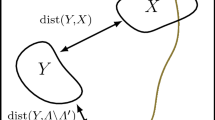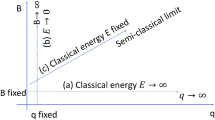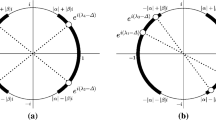Abstract
Recently, the stability of certain topological phases of matter under weak perturbations was proven. Here, we present a short, alternate proof of the same result. We consider models of topological quantum order for which the unperturbed Hamiltonian H 0 can be written as a sum of local pairwise commuting projectors on a D-dimensional lattice. We consider a perturbed Hamiltonian H = H 0 + V involving a generic perturbation V that can be written as a sum of short-range bounded-norm interactions. We prove that if the strength of V is below a constant threshold value then H has well-defined spectral bands originating from the low-lying eigenvalues of H 0. These bands are separated from the rest of the spectrum and from each other by a constant gap. The width of the band originating from the smallest eigenvalue of H 0 decays faster than any power of the lattice size.
Similar content being viewed by others
References
Wen, X.G., Niu, Q.: Ground-state degeneracy of the fractional quantum Hall states in the presence of a random potential and on high-genus Riemann surfaces. Phys. Rev. B41, 9377 (1990)
Kitaev A.: Fault-tolerant quantum computation by anyons. Ann. Phys. 303, 2 (2003)
Bravyi S., Hastings M.B., Michalakis S.: Topological quantum order: stability under local perturbations. J. Math. Phys. 51, 093512 (2010)
Lieb E.H., Robinson D.W.: The finite group velocity of quantum spin systems. Commun. Math. Phys. 28, 251 (1972)
Hastings M.B.: Lieb-Schultz-Mattis in higher dimensions. Phys. Rev. B 69, 104431 (2004)
Nachtergaele B., Sims R.: Lieb-Robinson bounds and the exponential clustering theorem. Commun. Math. Phys. 265, 119 (2006)
Hastings M.B., Xiao-Gang W.: Quasi-adiabatic continuation of quantum states: the stability of topological ground state degeneracy and emergent gauge invariance. Phys. Rev. B 72, 045141 (2005)
Osborne T. J.: Simulating adiabatic evolution of gapped spin systems. Phys. Rev. A 75, 032321 (2007)
Kennedy T., Tasaki H.: Hidden symmetry breaking and the Haldane phase in S = 1 quantum spin chains. Commun. Math. Phys. 147, 431–484 (1992)
Yarotsky D.A.: Ground states in relatively bounded quantum perturbations of classical lattice systems. Commun. Math. Phys. 261, 799–819 (2006)
Klich I.: On the stability of topological phases on a lattice. Ann. Phys. 325(10), 2120–2131 (2010)
Kirkwood J., Thomas L.: Expansions and phase transitions for the ground state of quantum ising lattice systems. Commun. Math. Phys. 88, 569–580 (1983)
Datta N., Kennedy T.: Expansions for one quasiparticle states in spin 1/2 systems. J. Stat. Phys. 108, 373 (2002)
Yarotsky D.: Perturbations of ground states in weakly interacting quantum spin systems. J. Math. Phys. 45(6), 2134 (2004)
Bravyi S., DiVincenzo D., Loss D.: Polynomial-time algorithm for simulation of weakly interacting quantum spin systems. Commun. Math. Phys. 284, 481–507 (2008)
Hastings M.B.: Solving gapped Hamiltonians locally. Phys. Rev. B 73, 085115 (2006)
Kitaev A.: Anyons in an exactly solved model and beyond. Ann. Phys. 321, 2–111 (2006) see Proposition D.1
Levin M.A., Wen X.-G.: String-net condensation: a physical mechanism for topological phases. Phys. Rev. B 71, 045110 (2005)
Freedman, M.H., Kitaev, A., Larsen, M.J., Wang, Z.: Topological quantum computation. http://arXiv.org/abs/quant-ph/0101025v2, 2002
Bravyi S., Hastings M.B., Verstraete F.: Lieb-Robinson bounds and the generation of correlations and topological quantum order. Phys. Rev. Lett. 97, 050401 (2006)
Bravyi S., Poulin D., Terhal B.: Tradeoffs for reliable quantum information storage in 2D systems. Phy. Rev. 104, 050503 (2010)
Kato T.: Perturbation theory for linear operators. Springer-Verlag, New York (1966)
Hastings, M.B.: http://arXiv.org/abs/1001.5280v2 [math-phy], 2010
Hastings M.B., Koma T.: Spectral gap and exponential decay of correlations. Commun. Math. Phys. 265, 781 (2006)
Ingham A.E.: A note on Fourier transforms. J. London Math. Soc. 9, 29 (1934)
Author information
Authors and Affiliations
Corresponding author
Additional information
Communicated by I.M. Sigal
Rights and permissions
About this article
Cite this article
Bravyi, S., Hastings, M.B. A Short Proof of Stability of Topological Order under Local Perturbations. Commun. Math. Phys. 307, 609–627 (2011). https://doi.org/10.1007/s00220-011-1346-2
Received:
Accepted:
Published:
Issue Date:
DOI: https://doi.org/10.1007/s00220-011-1346-2




